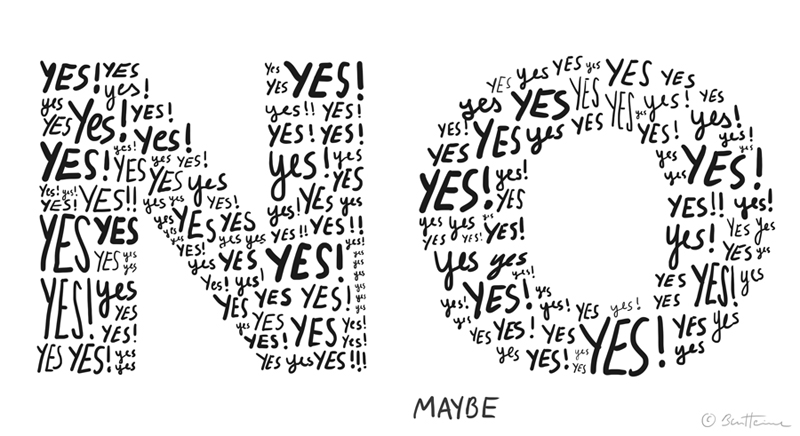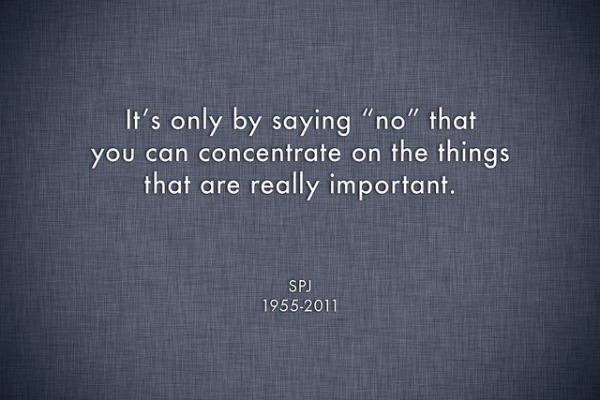
Photo Credit: Ben Heine via Compfight cc
Saying no to food — the Indian way vs. the American way
First, let me paint a typical scene in an Indian marriage:
It is a sit-down-and-eat kind of dinner at a marriage ceremony. The catering staff serves the food one course at a time, and attentive hosts hover around to make sure everyone is being fed properly. The fish fry is really good, and the waiter is making a round for seconds. When offered a fry, you politely say “No”. The waiter coaxes you, “Ek aur toh leejiye” (“Do take one more”). But you still refuse. As if on cue, the attentive host rushes to the scene, and personally picks up the two largest pieces of fish fry and dishes them on your plate, “Arre, khaaiye toh!” (“You must eat well at our party, Sir!”). Now you are happy and you dig into the fish. The initial refusal was just customary — in your heart, you always wanted the second fry. In the end, it was all a well orchestrated routine. One that has been going on for centuries in India.
In Gwalior in Madhya Pradesh, my uncle tells me that they take it to a whole different level. But before I describe their way, let us take a moment to visualize how we would say “no” at the above-mentioned dinner party if we really meant it:
- Imagine that someone in front of you is trying to serve some food on your plate. You do not want the food. So here is what you do — using both your hands, you cover your plate (with the back of your hands facing upwards). This way, you have covered your plate and the server has no means to serve you food. Also, as if to underscore the fact that you do not want more food, you vigorously wave your hands in a gesture of saying no (i.e. both hands moving in and out at the same time), while verbally pleading “nahi nahi nahi” (no-no-no) all the while.
Now the people of Gwalior have made two improvisations to this universal hand-gesture. By their improvisations, they would seem to be saying no, but would still get food served on their plate. Amazing, right? So here are the two versions:
- Like above-mentioned-hand-gesture, you use your hands to show that you are covering the plate. But this time, you intentionally keep your hands quite far apart. That way, the waiter can easily slip the food onto your plate. In the meantime, you keep waving your hands to “show” that you do not want the food. Verbal pleading and vigorous shaking of head to plead no can be added for extra dramatic effect.
- The second trick is a true piece of art. Again, you make the gesture of covering your plate, and are keep them conveniently far apart. This time, while waving no, you also angle the inner faces of your hands — this creates the appearance of something being poured downwards. As if the waiter needed guidance about where you want the food to be (NOT) served on the plate!
Now, let’s move to another part of the world — the United States of America.
Imagine your first year in the USA — you are literally ‘fresh off the boat’ (FOB). A Professor or your host-family has kindly invited you to dinner on your first Thanksgiving here. You enjoy the company quite a lot. But having sustained yourself on frozen paratha-s (Indian bread) and Ramen since you got off the boat, you are frankly enjoying the food more. So when a second round of servings are offered, you are eager to get seconds for everything. Ingrained with the Indian way of saying no when food is offered, you politely refuse (you think that the food is going to be served anyway — you are the guest after all!). But wait. The hostess promptly accepts your refusal and moves to the next person on the table. Your chance is gone! And with this painful “hunger-inducing” experience, you are initiated to the ways of the American — do not say “no” to food unless you really mean it.
With this prelude about the differing usage of the word “no” in two different cultures, let us get to more worldly matters — the matter of careers, personal life, and the power of the refusal in these matters.
“No” – the most powerful word in the dictionary
 During my two years of work in India, I had the opportunity to interact with Dr Partha Pratim Das, or PPD as we called him. Now, PPD was one of the sharpest and smartest people I had ever met. I also observed that he was able to complete an amazing amount of stuff during his work-week. Firstly, he was Head of Engineering at the Kolkata office — that meant that he had to be involved in ten or more projects at any given time. Naturally, he spent a lot of time in meetings, tele-conferences and business related travel. He also led the technical publications team at the office, something which is often ignored by technologists. He was always abreast of latest technological developments in computer science and software engineering, and devoted a major chunk of his time for such study. Despite doing all this, he was extremely approachable. He always seemed to be ready for a chat, and you would regularly find him in the corridors doing exactly that. Also I am sure that PPD received a ton of emails — yet he was able to reply back to many of my emails (technical and non-technical) with astounding amount of detail and insight.
During my two years of work in India, I had the opportunity to interact with Dr Partha Pratim Das, or PPD as we called him. Now, PPD was one of the sharpest and smartest people I had ever met. I also observed that he was able to complete an amazing amount of stuff during his work-week. Firstly, he was Head of Engineering at the Kolkata office — that meant that he had to be involved in ten or more projects at any given time. Naturally, he spent a lot of time in meetings, tele-conferences and business related travel. He also led the technical publications team at the office, something which is often ignored by technologists. He was always abreast of latest technological developments in computer science and software engineering, and devoted a major chunk of his time for such study. Despite doing all this, he was extremely approachable. He always seemed to be ready for a chat, and you would regularly find him in the corridors doing exactly that. Also I am sure that PPD received a ton of emails — yet he was able to reply back to many of my emails (technical and non-technical) with astounding amount of detail and insight.
I was perplexed. Here I was, fresh out of undergrad, working on just ONE project, and yet feeling backlogged with work, emails and personal goals. And there was PPD, twenty years my senior, managing so much work with amazing efficiency. One day, in a meeting with PPD, some other colleagues and I requested him to explain what his efficiency secret was.
PPD’s answer was simple, “I know when to say ‘No'”.
I was confused — how was this related to work efficiency and time management? Fortunately PPD gave us some more insights. I rephrase below his advice, as I remember it six years henceforth:
The word “no” is probably the most powerful word in the dictionary. At different points in your life, people might approach you asking you for something. It might be something at work, like someone asking for your time and involvement in a certain project. Or it might be something in your personal life, like someone inviting you to dinner.
Many a times, we find ourselves half-heartedly saying yes. We might already be very busy with our current projects and not have time to take on another thing. We may have some personal plans on the day of the dinner invitation. But we fear that we may offend/hurt the person who is asking if we say no. So we go along with what tradition tells us to do — we say yes.
PPD’s advice was that saying yes does not always help the person who is asking. If you said yes to John about getting involved in a new project (say project Y) but could not put your 100% into it, no one wins. First, your work quality in your current project suffers. And maybe another person (Jack) would have been able to devote more time to project Y and would have been a greater help. If you had simply said no, John would probably have asked Jack and everyone would have been the better for it.
As for the dinner invitation, if you had some personal stuff planned on that date, you might think that the personal stuff can wait a little longer, and you can make an exception to keep your host’s heart. You think this is a one-time thing. But more often that not, this becomes a habit, and the personal work keeps getting pushed back. Instead, you can politely say that you had something planned already for the evening, and that you would not be able to honor the invitation. But what if the person inviting you were to take offense at your refusal? To avoid this, you would need to be consistent about your stance over time. Then, your friends and family would understand and no one would leave feeling snubbed.
So, should we all turn American?
PPD’s advice stuck with me through the years. Also, I happened to travel to travel to USA for my Ph.D. degree and took up a job here this year. It took me some time (and some missed second rounds of turkey and pumpkin pie) but I realized that — here, when a person said “no”, he/she usually meant it. And others accepted without taking offense.
Be it offers for seconds, dinner invitations, requests for project participation or anything, an individual’s personal preference is taken into consideration. Here, the phrase ‘freedom’ is applicable to every level of an individual’s life.
Here is something Steve Jobs said about the matter of saying “no”:

[Image credit: framedfrosting.com via Pinterest]
I am not saying that all things American are good. There are many things that are worth criticizing/questioning — an overabundance of guns, frozen dinners, distant neighbors, to name a few. And there are many things in India that make it the wonderful country that it is. Yet, every culture should adapt. And maybe it is time for us Indians to change.
Individual freedom is essential for the technological, creative, and economic growth of a nation. Being part of a crowd never led a person to create great pieces of art, or make fascinating inventions. As pointed out in my previous article, Indians are always pointing out to each other what should be done. Maybe now, we need to listen to our inner voices, and begin to say “no” to what others demand of us.
And it may be just such a change in mindset that is required to herald a new era of growth in our country.
Finally, as to the matter of how we say “no” at Indian dinner events, well, that should probably remain unchanged. It is a way too hilarious and entertaining a tradition to let go off.
